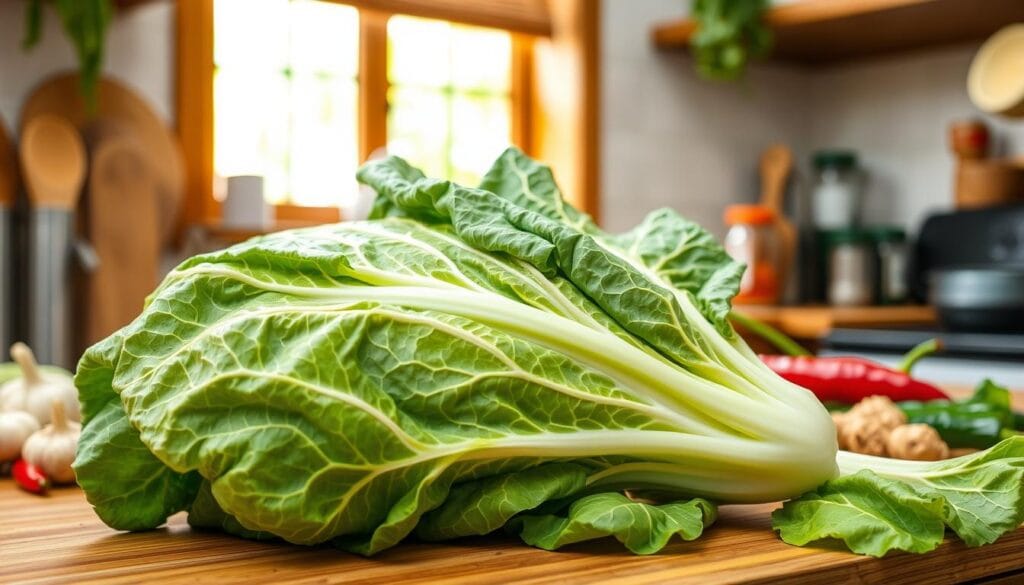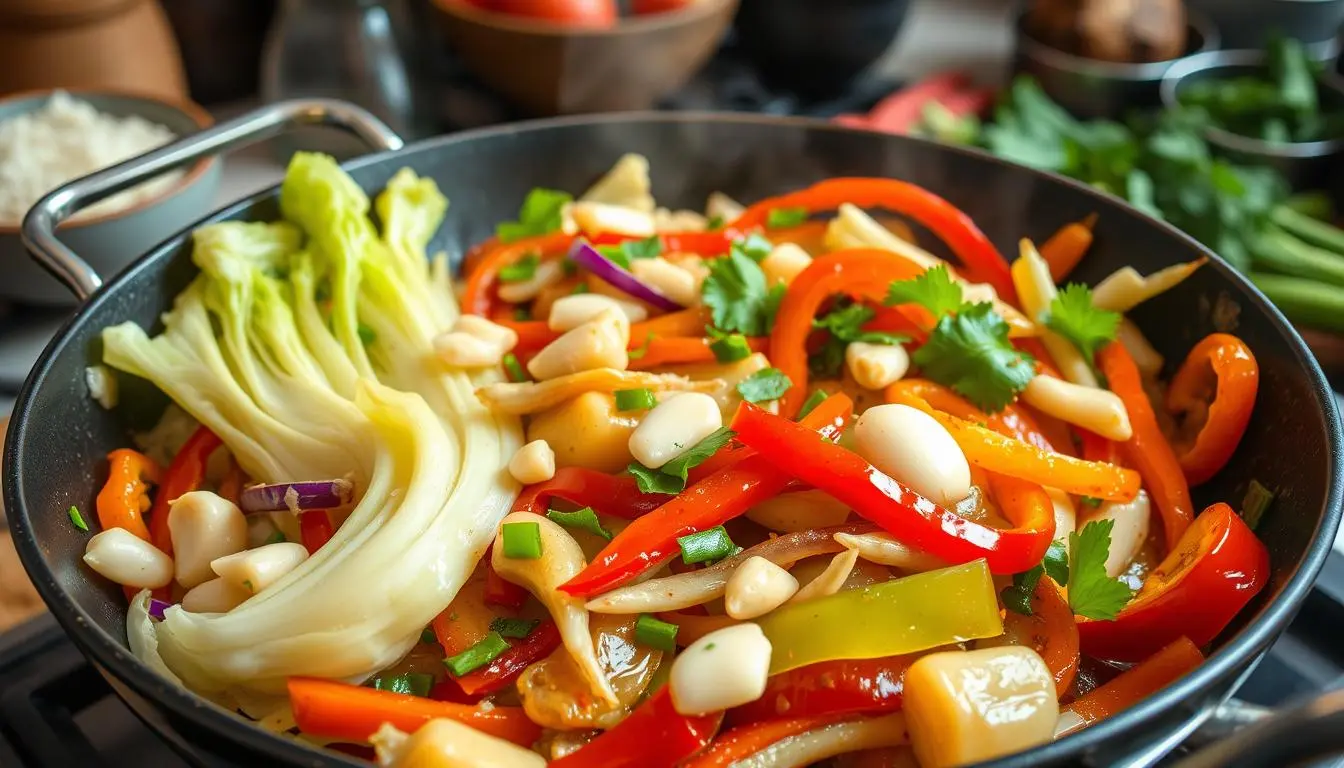As the seasons change and the air gets crisp, “cooking napa cabbage” becomes a perfect way to embrace autumn’s vibrant greens. This humble yet versatile vegetable stands out as a true culinary gem, with its delicate texture and subtle sweetness that enhance any dish.
Table of Contents
Napa cabbage is a staple in East Asian cuisines, cherished by families from Japan to Korea. Its ability to thrive in cold weather makes it ideal for hearty stews, savory stir-fries, and refreshing slaws. Whether you’re an experienced chef or new to cooking, this article will show you how to elevate your meals with napa cabbage.

- Napa cabbage is a versatile and nutritious vegetable that thrives in cooler climates.
- It can be enjoyed raw or cooked, adding depth and flavor to a variety of dishes.
- Napa cabbage is a staple ingredient in East Asian cuisines, with a wide range of preparation methods.
- Recipes featuring napa cabbage range from quick stir-fries to hearty soups and stews.
- Napa cabbage can be a healthy substitute for traditional wraps and slaws.
Understanding Napa Cabbage: An Asian Culinary Staple
Napa cabbage, also known as Chinese cabbage or hakusai in Japanese, is a versatile and nutritious member of the Brassica family. It has a milder, more delicate flavor than regular cabbage. When cooked, it develops a sweet taste. Its unique characteristics make it a beloved ingredient in many Asian cuisines.
What Makes Napa Cabbage Different from Regular Cabbage
Napa cabbage has a distinct oblong shape with ruffled, pale-veined leaves that grow upwards, reaching up to 12 inches in height. Regular cabbage has a round head with densely wrapped leaves, typically weighing between 2 and 4 pounds. Additionally, napa cabbage has a slightly sweet and crunchy texture, while cooked green cabbage develops a milder, earthy flavor.
Nutritional Benefits and Storage Tips
Napa cabbage is a powerhouse of essential vitamins and minerals, including vitamins A, C, and K, as well as fiber and antioxidants. Steaming napa cabbage for 3-5 minutes helps retain its nutrients and flavor, while stir-frying it for 5-7 minutes with garlic and ginger enhances its taste. To ensure optimal freshness, store napa cabbage in the refrigerator and avoid letting the leaves wilt or become limp.
Selecting the Perfect Napa Cabbage
When choosing napa cabbage, look for heads with crisp, bright-green leaves and a firm, white stem. Steer clear of any that look wilted or have faded leaves. Napa cabbage can be found in Asian markets and some major grocery stores, and it’s available year-round, thriving in warm climates like California’s Salinas Valley.
“Napa cabbage is a rich source of vitamins B6, B9, C, and K, calcium, iron, manganese, copper, and antioxidants, making it a nutritional powerhouse.”
Essential Tips for Preparing Napa Cabbage
Cooking napa cabbage is easy. Just follow these tips to make your dishes taste great every time.
Start by separating the leaves from the stalks. The leaves wilt fast, so cook them separately. You can enjoy napa cabbage raw or cooked. For salads or slaws, shred the leaves finely.
Napa cabbage is great for pickling and in stir-fries or soups. In East Asian dishes, it’s used in hot pots and stews. It’s sweet and tender. Cook the leaves and stalks differently to get the best texture.
| Storage Tip | Napa cabbage keeps well in the fridge, wrapped in plastic. It lasts 10 to 14 days in airtight containers. |
|---|---|
| Preservation Method | To keep its flavor, blanch the leaves in boiling water. Then, cool them in an ice bath. |
| Cooking Tools | Use a stainless steel knife and mandolin for easy cutting and shredding. |
Napa cabbage is full of nutrients. It adds crunch and flavor to many dishes. With these tips, you’ll enjoy cooking napa cabbage at home.
Traditional Asian Cooking Methods with Napa Cabbage
Napa cabbage is a favorite in Asian cooking. It’s great for quick stir-fries and slow braises. This veggie is versatile and delicious in many ways.
Stir-Frying Techniques
Stir-frying stir-fried napa cabbage is quick and keeps it crunchy. Cook in small batches and stir constantly. Add garlic, ginger, and sauce for a tasty dish.
Braising and Steaming Methods
Braised napa cabbage is tender and flavorful. It’s cooked in a rich liquid. Steaming is healthier and keeps nutrients, adding a light flavor.
Fermentation Basics
Kimchi napa cabbage is a Korean favorite. It’s fermented to be probiotic-rich and flavorful. Salting, massaging, and fermenting make it tangy and delicious.
Napa cabbage is perfect for stir-fries, braises, or fermentation. It adds texture and flavor to Asian dishes.

“Napa cabbage is a versatile and nutritious vegetable that deserves a place in every home cook’s repertoire. Exploring its traditional preparations opens up a whole new world of flavor and texture.”
Quick and Easy Stir-Fried Napa Cabbage Recipes
Stir-fried napa cabbage is a tasty and quick meal. It’s made with garlic, soy sauce, and black pepper. This mix is great for a busy weeknight dinner.
Adding smoked bacon can add a smoky flavor to your cabbage stir-fry. But, you can also enjoy it without bacon for a vegetarian option.
Consider stir-frying napa cabbage with pork belly in katsuo dashi broth for a gourmet dish. It’s simple to prepare and ideal for any occasion.
| Sesame Chicken & Napa Cabbage Stir-Fry |
|---|
| Average rating: 4.69 starsNutritional information per serving: Calories: 211kcal, Carbohydrates: 13.8g, Protein: 27.2g, Fat: 5.1g, Saturated Fat: 0.6g, Cholesterol: 50mg, Sodium: 696mgPreparation time: 10 minutesCooking time: 20 minutesTotal time: 30 minutesServings: 4 |
This Sesame Chicken & Napa Cabbage Stir-Fry is quick and easy. It uses chicken breasts, onion, red pepper, and napa cabbage. The sauce has ginger, garlic, and soy sauce, with a sesame oil finish. Top it with scallions for color and freshness.
Looking for a simple or fancy napa cabbage dish? These recipes are a tasty way to add this versatile vegetable to your meals.

Hearty Napa Cabbage Soups and Stews
Napa cabbage is a versatile ingredient that shines in comforting winter soups and stews. It adds heartiness and nutrition to cold-weather meals. From classic hot pot variations to creamy pasta dishes, it’s a star.
Hot Pot Variations
One of the most beloved ways to enjoy napa cabbage is in a hot pot, or nabé dish. The Japanese mille-feuille nabe features slices of pork belly and napa cabbage simmered in a savory dashi broth. Another popular hot pot, yosenabe, is a great way to use up leftover napa cabbage and other ingredients. These one-pot meals are perfect for cozy nights in.
Comforting Winter Recipes
For a Western twist on napa cabbage, try a creamy napa cabbage soup or stew. The soup, at just 315 calories per serving, provides 17g of carbs, 25g of protein, and 4g of fiber. Leftovers can be stored for up to 4 days or frozen for months. Another comforting option is a napa cabbage pasta dish, where the cabbage is combined with a creamy sauce and topped with a crunchy panko breadcrumb topping.

“Napa cabbage is a staple ingredient in many Asian cuisines, but it also shines in Western-style soups and stews. These hearty, comforting dishes are perfect for warming up on a chilly day.”
Fresh and Crispy Napa Cabbage Salad Ideas
Napa cabbage is tender, sweet, and juicy. It’s perfect for salads and slaws. Mix it with a tangy sesame dressing for a vibrant dish. It goes well with BBQ meats, tacos, ahi tuna steak, and Asian meals.
Adding edamame, mango, or sliced jalapeños to your napa cabbage salad or Asian slaw boosts flavor and texture. You can make many fresh and crisp salads with napa cabbage. They look great and taste amazing.
| Ingredient | Quantity |
|---|---|
| Napa cabbage, shredded | 4 cups |
| Snow peas, sliced diagonally | 1 cup |
| Radicchio, thinly sliced | 1/2 cup |
| Scallions, thinly sliced | 1/2 cup |
| Toasted almond slices | 1/4 cup |
| Miso Ginger Dressing | 1/2 cup |
For a great napa cabbage salad, choose fresh, crisp cabbage. Use a small head and make the salad just before serving. The dressing can be made ahead and kept in the fridge for two weeks.
Customize your Asian slaw with your favorite ingredients. Try bell peppers, avocado, tofu, chicken, or shrimp. Napa cabbage is versatile and makes salads that are both fresh and delicious.
Creative Ways for Cooking Napa Cabbage
Napa cabbage is a favorite in Asian cooking, but it’s more than just stir-fries and soups. Its leaves can turn into many tasty dishes. You can make everything from napa cabbage rolls to unique fusion recipes.
Cabbage Rolls and Wraps
Napa cabbage leaves are great for low-carb wraps. Try making napa cabbage rolls with ground meat, rice, and spices. The leaves wrap around the filling, making a healthy and tasty meal.
Fusion Recipes
For something new, try fusion napa cabbage recipes. They mix Asian flavors with global tastes. For example, okonomiyaki, a Japanese pancake, uses napa cabbage. It’s crispy and full of flavor.
Napa cabbage lets you make new versions of old dishes and try out new tastes. Whether you’re making rolls or fusion dishes, it’s a fun culinary adventure.
Preservation Methods and Leftover Ideas
Napa cabbage is a versatile Asian vegetable. It can be preserved and repurposed in many tasty ways. One favorite method is pickling, turning the cabbage into a tangy side dish. It’s great with rice or in Asian-inspired meals.
When you have leftover napa cabbage, there are lots of creative recipes to try. You can add the shredded leaves to stir-fries, soups, or even dumplings. Quick kimchi recipes are also a great way to use up the cabbage. They make a probiotic-rich condiment without long fermentation.
- Pickle napa cabbage for a tangy, versatile side dish
- Repurpose leftover napa cabbage in stir-fries, soups, and dumplings
- Make quick kimchi to enjoy the benefits of fermented napa cabbage
“Napa cabbage is such a versatile ingredient, and there are so many delicious ways to preserve and use up every last leaf.”
Whether you’re preserving napa cabbage or finding creative ways to use leftovers, these methods are great. They help you enjoy this nutritious and flavorful Asian staple to the fullest.
Conclusion
Napa cabbage is a versatile ingredient that can make many dishes better. It’s great for both raw and cooked dishes. This lets you try different ways of cooking and enjoy its full flavor.
It’s perfect for stir-fries, braising, or adding to soups and stews. Napa cabbage brings a nice mix of flavors and textures. Knowing about different types of Napa cabbage helps you make recipes that you’ll love.
Exploring cooking napa cabbage and trying napa cabbage recipes opens up new culinary adventures. Let your creativity flow as you make tasty and healthy dishes. Show off Napa cabbage’s versatility in your cooking.
FAQ
What is napa cabbage and how is it different from regular cabbage?
Napa cabbage, also known as Chinese cabbage or hakusai, has an oblong shape. It has ruffled leaves and thick white ribs. Its flavor is milder and more delicate than regular green or red cabbage.
What are the nutritional benefits of napa cabbage?
Napa cabbage is low in calories but rich in nutrients. It’s a good source of folate and Vitamin B. It also has lots of fiber and antioxidants.
How should I select and store napa cabbage?
Choose napa cabbage with firm, crisp leaves and stems. Avoid wilted leaves. Store it in the fridge, wrapped in a damp paper towel, for up to a week.
What are some common cooking methods for napa cabbage?
Enjoy napa cabbage raw in salads and slaws. Or cook it by stir-frying, braising, steaming, and even fermenting for kimchi.
How can I quickly stir-fry napa cabbage?
Stir-fry napa cabbage with garlic, soy sauce, and black pepper. Add smoked bacon or pork belly for extra flavor.
What are some hearty napa cabbage soup and stew recipes?
Try Mille-feuille nabe, a Japanese hot pot with napa cabbage and pork belly. Yosenabe, a versatile hot pot using leftover napa cabbage, is also great for winter.
How can I use napa cabbage in salads and slaws?
Use napa cabbage as a base for salads and slaws. Pair it with tangy sesame dressing, edamame, mango, or sliced jalapeños for a refreshing dish.
What are some creative ways to use napa cabbage?
Use napa cabbage leaves to make healthy, low-carb rolls. Try fusion recipes like okonomiyaki, a savory Japanese pancake with chopped napa cabbage.
How can I preserve and use up leftover napa cabbage?
Preserve napa cabbage through pickling for a tangy side dish. Use leftover napa cabbage in stir-fries, soups, or as a filling for dumplings. Quick kimchi is another way to use it up.

